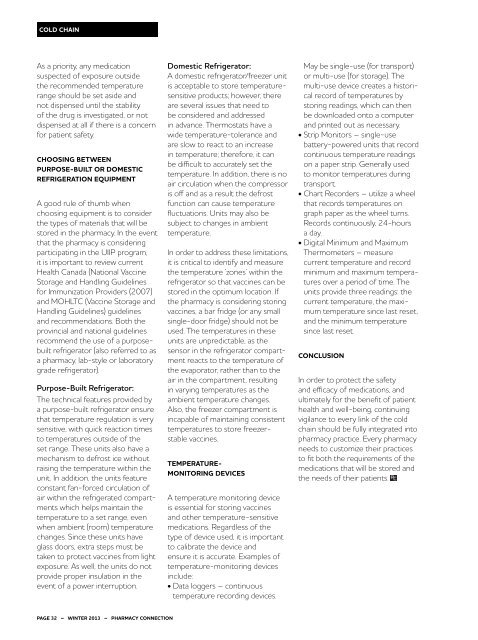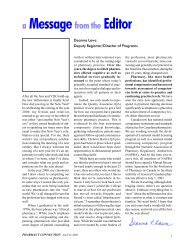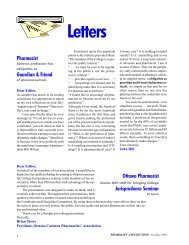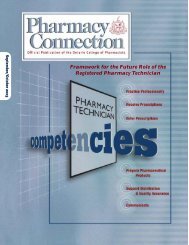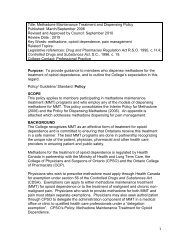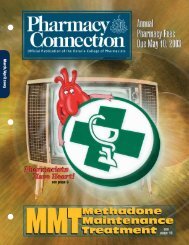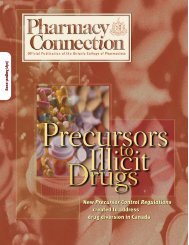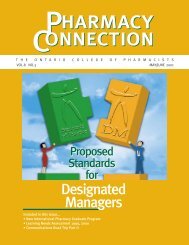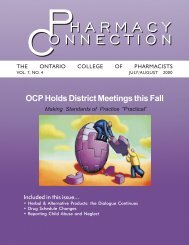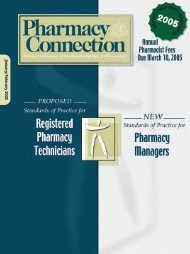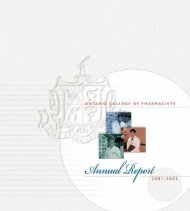Download - Ontario College of Pharmacists
Download - Ontario College of Pharmacists
Download - Ontario College of Pharmacists
Create successful ePaper yourself
Turn your PDF publications into a flip-book with our unique Google optimized e-Paper software.
COLD CHAIN<br />
As a priority, any medication<br />
suspected <strong>of</strong> exposure outside<br />
the recommended temperature<br />
range should be set aside and<br />
not dispensed until the stability<br />
<strong>of</strong> the drug is investigated, or not<br />
dispensed at all if there is a concern<br />
for patient safety.<br />
Choosing Between<br />
Purpose-built or Domestic<br />
Refrigeration Equipment<br />
A good rule <strong>of</strong> thumb when<br />
choosing equipment is to consider<br />
the types <strong>of</strong> materials that will be<br />
stored in the pharmacy. In the event<br />
that the pharmacy is considering<br />
participating in the UIIP program,<br />
it is important to review current<br />
Health Canada (National Vaccine<br />
Storage and Handling Guidelines<br />
for Immunization Providers (2007)<br />
and MOHLTC (Vaccine Storage and<br />
Handling Guidelines) guidelines<br />
and recommendations. Both the<br />
provincial and national guidelines<br />
recommend the use <strong>of</strong> a purposebuilt<br />
refrigerator (also referred to as<br />
a pharmacy, lab-style or laboratory<br />
grade refrigerator).<br />
Purpose-Built Refrigerator:<br />
The technical features provided by<br />
a purpose-built refrigerator ensure<br />
that temperature regulation is very<br />
sensitive, with quick reaction times<br />
to temperatures outside <strong>of</strong> the<br />
set range. These units also have a<br />
mechanism to defrost ice without<br />
raising the temperature within the<br />
unit. In addition, the units feature<br />
constant fan-forced circulation <strong>of</strong><br />
air within the refrigerated compartments<br />
which helps maintain the<br />
temperature to a set range, even<br />
when ambient (room) temperature<br />
changes. Since these units have<br />
glass doors, extra steps must be<br />
taken to protect vaccines from light<br />
exposure. As well, the units do not<br />
provide proper insulation in the<br />
event <strong>of</strong> a power interruption.<br />
Domestic Refrigerator:<br />
A domestic refrigerator/freezer unit<br />
is acceptable to store temperaturesensitive<br />
products; however, there<br />
are several issues that need to<br />
be considered and addressed<br />
in advance. Thermostats have a<br />
wide temperature-tolerance and<br />
are slow to react to an increase<br />
in temperature; therefore, it can<br />
be difficult to accurately set the<br />
temperature. In addition, there is no<br />
air circulation when the compressor<br />
is <strong>of</strong>f and as a result the defrost<br />
function can cause temperature<br />
fluctuations. Units may also be<br />
subject to changes in ambient<br />
temperature.<br />
In order to address these limitations,<br />
it is critical to identify and measure<br />
the temperature ‘zones’ within the<br />
refrigerator so that vaccines can be<br />
stored in the optimum location. If<br />
the pharmacy is considering storing<br />
vaccines, a bar fridge (or any small<br />
single-door fridge) should not be<br />
used. The temperatures in these<br />
units are unpredictable, as the<br />
sensor in the refrigerator compartment<br />
reacts to the temperature <strong>of</strong><br />
the evaporator, rather than to the<br />
air in the compartment, resulting<br />
in varying temperatures as the<br />
ambient temperature changes.<br />
Also, the freezer compartment is<br />
incapable <strong>of</strong> maintaining consistent<br />
temperatures to store freezerstable<br />
vaccines.<br />
Temperature-<br />
Monitoring Devices<br />
A temperature monitoring device<br />
is essential for storing vaccines<br />
and other temperature-sensitive<br />
medications. Regardless <strong>of</strong> the<br />
type <strong>of</strong> device used, it is important<br />
to calibrate the device and<br />
ensure it is accurate. Examples <strong>of</strong><br />
temperature-monitoring devices<br />
include:<br />
• Data loggers – continuous<br />
temperature recording devices.<br />
May be single-use (for transport)<br />
or multi-use (for storage). The<br />
multi-use device creates a historical<br />
record <strong>of</strong> temperatures by<br />
storing readings, which can then<br />
be downloaded onto a computer<br />
and printed out as necessary.<br />
• Strip Monitors – single-use<br />
battery-powered units that record<br />
continuous temperature readings<br />
on a paper strip. Generally used<br />
to monitor temperatures during<br />
transport.<br />
• Chart Recorders – utilize a wheel<br />
that records temperatures on<br />
graph paper as the wheel turns.<br />
Records continuously, 24-hours<br />
a day.<br />
• Digital Minimum and Maximum<br />
Thermometers – measure<br />
current temperature and record<br />
minimum and maximum temperatures<br />
over a period <strong>of</strong> time. The<br />
units provide three readings: the<br />
current temperature, the maximum<br />
temperature since last reset,<br />
and the minimum temperature<br />
since last reset.<br />
Conclusion<br />
In order to protect the safety<br />
and efficacy <strong>of</strong> medications, and<br />
ultimately for the benefit <strong>of</strong> patient<br />
health and well-being, continuing<br />
vigilance to every link <strong>of</strong> the cold<br />
chain should be fully integrated into<br />
pharmacy practice. Every pharmacy<br />
needs to customize their practices<br />
to fit both the requirements <strong>of</strong> the<br />
medications that will be stored and<br />
the needs <strong>of</strong> their patients.<br />
PAGE 32 ~ WINTER 2013 ~ PHARMACY CONNECTION


